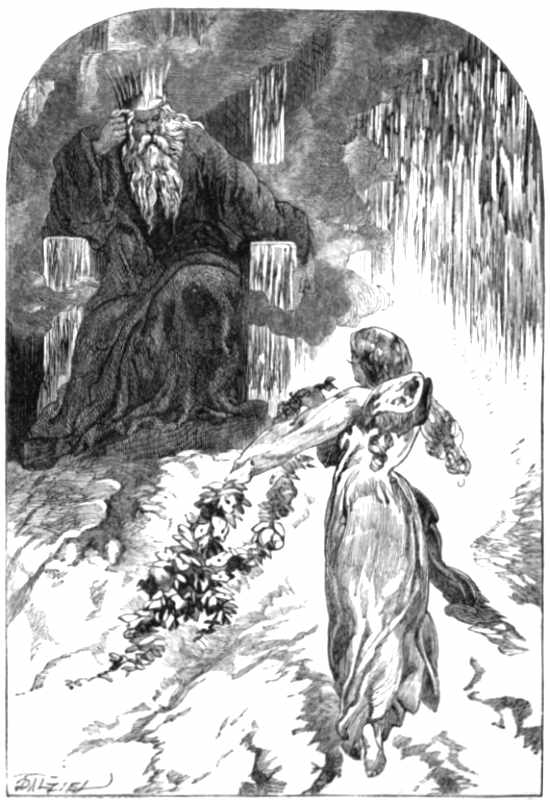The Frost King, the Frost-King, or King Frost, is a personification of Autumn frost, or of cold, frosty weather in general, who is portrayed as a king. Beyond this basic description, public domain stories are very inconsistent in their depictions of the character: Sometimes he is artistic and benign, bearing a resemblance to Jack Frost, and other times destructive and even villainous, resembling Old Man Winter. Some stories portray him as having a queen, but most sources don’t mention her. In L. Frank Baum’s books, he is an immortal who reigns during Winter. His birthday is the coldest day of the year. His son, Jack Frost, is mischievous, but the Frost King never reproves him for his pranks. The various personifications of cold weather or wintertime are often conflated and confused with one another in public domain stories. Jack Frost has at times been depicted as a king and called King Frost, and Ded Moroz is often called King Frost in English translations. Santa Claus has also been portrayed as a king.
| Alias The Frost King |
| Real Names/Alt Names Frost |
| Characteristics Personification, Myths & Legends, Icemaker, Realism and Victorian Age |
| Creators/Key Contributors Lydia Sigourney |
| First Appearance Poems (1834) |
| First Publisher Key & Biddle |
| Appearance List “Autumn” in Poems by Lydia H. Sigourney (1834); “King Frost” by Charles Swain in The Literary Gazette and Journal of Belles Lettres, Arts, Sciences, &c., (no. 1047, 11 Feb. 1837); “The Mind and Other Poems” by Charles Swain (reprint, 1841); “Frost and the Flower Garden” by Lydia H. Sigourney, The New‐Yorker (vol. 4, no. 15, whole no. 93, 30 Dec. 1837); Select Poems, 3rd ed., by Lydia H. Sigourney (reprint, 1838); “Lyrics by Nemo No. XXV” in The Star (vol. 1, no. 26, 10 Feb. 1838); “The Conquests of King Frost” as part of “A Familiar Letter to a Friend” by Sarah Carter Edgarton, The Universalist and Ladies’ Repository (vol. 10, no. 8, Jan. 1842); “The Frost‐King: or, The Power of Love” in Flower Fables, by Louisa May Alcott (1855); The Frost-King or The Power of Love Illustrated Brothers Dalziel (1855); “The Frost‐King; or, The Power of Kindness, and How It Prevailed Over Fear and Cruelty” by Louisa May Alcott (reprint, 1858); “The Blue‐Bird’s Complaint” in The Friend of Youth, and Child’s Magazine, (vol. 2, no. 13, Jan. 1861); “Frost and Thaw” in Punch (vol. 40, no. 1020, 26 Jan. 1861); “The Frost‐King” in Rhymes and Jingles by Mary Mapes Dodge (1882); “The Brook’s Song” by Mrs. M. F. Butts, St. Nicholas (vol. 11, no. 9, July 1884); “The Frost King and How the Fairies Conquered Him” in Lulu’s Library, vol. 2, by Louisa May Alcott (1887); “King Frost” by Zelia M. Brown in “Child‐Garden of Story, Song and Play” (vol. 7, no. 3, Feb. 1899); “A Goal of Hopes” in Birds Uncaged and Other Poems by Burton L. Collins (1901); “A New Theory of Frost: or The Story of the Frost‐King” by A. E. Brackett; The Prize Poetical Speaker (1901); “The Frost King” in John Nagle’s Philosophy by John Nagle (1901); “The Runaway Shadows or A Trick of Jack Frost” (5 June 1901); The Life and Adventures of Santa Claus (1902); The Wizard of Oz (stage musical, 1902); “Why the Evergreen Trees Never Lose Their Leaves” in The Book of Nature Myths, by Florence Holbrook (1902); “Another Santa Claus” by Emma Bolenius, American Motherhood (vol. 35, no. 6, Dec. 1912); “The Rout of the Frost King, Being a Veritable Account of His Overthrow by the Zephyrs” in The Rout of the Frost King & Other Fairy Poems, by Eugène Neustadt (1914). |
| Sample Read The Yellow Fairy Book [Internet Archive] |
| Description The Frost King, the Frost-King, or King Frost, is a personification of Autumn frost, or of cold, frosty weather in general, who is portrayed as a king. Beyond this basic description, public domain stories are very inconsistent in their depictions of the character: Sometimes he is artistic and benign, bearing a resemblance to Jack Frost, and other times destructive and even villainous, resembling Old Man Winter. Some stories portray him as having a queen, but most sources don’t mention her. In L. Frank Baum’s books, he is an immortal who reigns during Winter. His birthday is the coldest day of the year. His son, Jack Frost, is mischievous, but the Frost King never reproves him for his pranks. The various personifications of cold weather or wintertime are often conflated and confused with one another in public domain stories. Jack Frost has at times been depicted as a king and called King Frost, and Ded Moroz is often called King Frost in English translations. Santa Claus has also been portrayed as a king. |
| Source Frost King – Public Domain Super Heroes Wiki |

